
Obtaining Food at Sea Menu: 1 2 3 4 5 6 7 8 9 10 11 Next>>
Obtaining Food at Sea During the Golden Age of Piracy, Page 10
Obtaining Food at Sea in the Late 17th and Early 18th Centuries - Fishing
Fishing to procure food while on a ship would seem inevitable, although fish alone would hardly have provided the 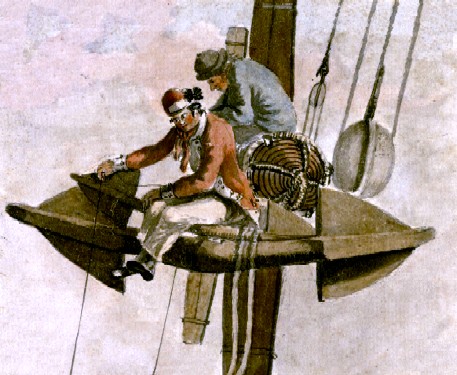
Artist: Gabriel Bray - A Marine and Sailor Fishing Off an Anchor (1775)
necessary diet for a sailor. The navy issued its first official printed regulations in 1731, codifying some practices which had been in place before their printing. Among them:
All Ships of War furnished with Fishing Tackle, being in such Places where Fish is to be had, the Captain may employ some of the Company in Fishing, and the Fish which shall be caught, shall be distributed daily to such Persons as are sick, or upon Recovery; and if there be any Surplus, the same shall be distributed by Turns amongst: the Messes of the Officers and Seamen, without Favour or Partiality, and Gratis1
This points out the need for fishing equipment. Even some of the pirates thought this important. In September of 1720, John Rackham's crew "took seven or eight Fishing-Boats in Harbour Island, stole their Nets and other Tackle, and then went off the French Part of Hispaniola"2. The account doesn't say whether they used the equipment to fish or sold it, however.
Of all the methods of procuring food other than purchasing or stealing it, fishing was the most widely used with 34 instances 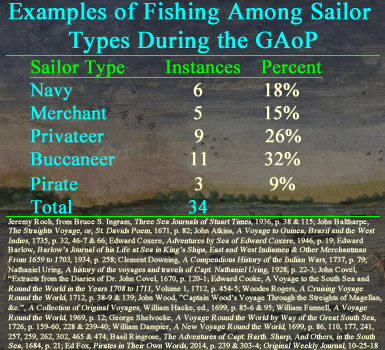
Examples of Fishing Among Sailor Types During the GAoP
Image Artist: Theodor de Bry - Natives Their manner of fishynge (1590)
recorded in the accounts under study. Note that the only accounts being included here specifically mention the act of fishing, although there are a variety of other accounts from which fishing could be inferred. For one example among many, Edward Barlow explained that when the East India ship Rainbow stopped at Mauritius in 1689, they found "store of good wild deer and wild goats and hogs, and sea and land turtles or tortoises, and plenty of fresh good fish."3 This strongly suggests that the crew was both hunting and fishing, but for the purposes of this section, only specific mentions of crew members actually fishing have been included in the data.
As with hunting, there are examples of fishing from each type of sailor. In addition, the support for fishing among the first three types of sailors is fairly widespread. The 6 instances of navy sailors fishing are taken from accounts written by four different authors, the 5 merchant vessel fishing examples are from five different authors and the 9 mentions of privateers fishing are found in five different accounts. This is not true among the buccaneers; all but one which tell of fishing are from William Dampier's first book. There is only slight support for pirates fishing for their food, although the three examples are all from different accounts.
As with some of the other categories, some of the mentions fishing contain little detail beyond the fact that the sailors fished. These include John Wood's account of the privateer crew of the 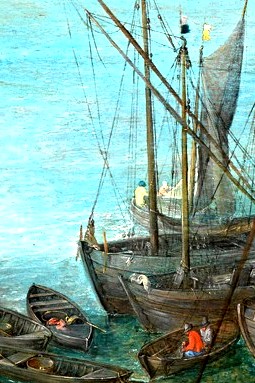
Artist: Jan Brueghel the Elder
Sailors Fishing, Det From The Great Fish Market (1603)
Sweepstakes fishing while at Puerto San Julián in 16704, the crew of the buccaneer vessel Revenge doing the same in 16855, privateer George Shelvocke's crew fishing while shipwrecked at Juan Fernandez in July of 17206, pirate Francis Spriggs sending their "Boat [out] with three hands to fish" while near Cabo Catoche, Mexico7and a newspaper account of an unnamed pirate vessel which spent two or three days fishing near Newfoundland in 1718.8
Many of the accounts mention the type of fish caught by the sailors. From the navy accounts, Jeremy Roch says that when HMS Antelope was at Asilah, Morocco in March of 1666, "we fell to fishing, here being plenty of Bonetas, Porgies [porgys - a type of Sea Bream] and Rock fish."9 In 1671, the St. David was near Roqueta de Mer, Spain, where John Baltharpe reported that they caught "store of Mullets"10. While aboard the Swallow at Santiago in the Cape Verde Islands in February of 1721, surgeon John Atkins explained that, "we had good Fishing with our Lines; took Breams (or Porgas [porgys]) Skip-jacks [skipjack tuna], Grouper, a Rock-fish (thick, short, and of a deep yellow on the Belly, Gills and Mouth) and the Jew-Fish"11. Two months later, HMS Swallow and Weymouth were fishing in the river near Sierra Leone, Africa where the caught "Ten-pounders [fish from the family Elopidae], Old-wives [probably Trachinotus goodei], Cavalloes [crevalle jack], Barricudoes, Sucking-Fish [probably remoras], Oysters, Cat-Fish, Bream, and Nun-Fish [some type of Elopidae]"12. In May, they were at 'Sesthos' (Cape Palmas, Liberia) "where we catched good store of Mullets, Soles, Bump noses [probably trevallies], and Rock fish"13.
The merchant vessel accounts are a little less expansive in their descriptions of what was caught. The London Merchant was at 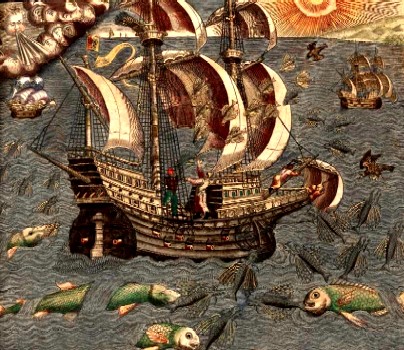
Artist: Theodor de Bry
Fish and Surround Ships in the Ocean, From America Part 5 (1594)
Tunis, Tunisia in November of 1670 where John Covel said they caught a few fish including "Mullet, Barboni [barbounia - red mullet], and our common [European] plaice and a little sort of what we call Maids [thornback rays]."14 Aboard the Fflorentine in 1675, merchant sailor Edward Barlow reported catching mackerel15. Nathaniel Uring said that when the merchant ship Martha was on the shoals of the Geba river in Guinea-Bissau he almost caught "a large broad Fish... commonly called amongst the Seamen Devil Fish [a type of sea ray]"16.
The privateers were even stingier in their descriptions of the fish they caught. Edward Cooke reported that when Woodes Rogers Duke and Dutchess were off the coast of Sheltand, Scotland in July of 1711, they "catch’d Ling, Cod, and other Fish"17. Rogers says in his book about the journey that "we sent our Yall a fishing, and got near 200 large Fish in a very little time" without specifying what they caught while at Juan Fernandez Island in February of 1709.18 William Funnell notes that when the privateer vessel St. George anchored off Ilha Grande, Brazil, there was "good fishing with the Saine [net]; Fish being very plentiful, and of various sorts, as the Silver-fish and several others."19
Nearly all of the buccaneer accounts come from William Dampier's account. He usually provides a lot of detail about the fauna encountered in his journeys, but, in reference to the fish caught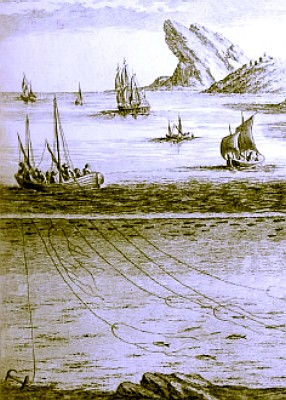
Fishing Above and Below, From Traite General des
Pesches, Plate 20 (1769)
, Dampier has less to say. All of his fishing accounts which mention the types of fish caught come from his time aboard the Cygnet under the captaincy of Charles Swan. The first is the most unusual. While at Puerto Angel, Mexico in October of 1685, the buccaneers "went into a Lagune, or Lake of Salt-water, where they found much dried Fish, and brought some aboard."20 In December, they were at the Chamela Islands on the coast of Mexico where they "caught plenty of Rock-fish with Hook and Line"21. By Christmas that year, they were by Isla Marietas in Mexico. There, the buccaneers "sent in 2 Canoas with the [Muskito Indian] Strikers [spear fishermen] to get Fish, being desirous to have a Christmas Dinner. In the Afternoon they returned aboard with 3 great Jew-fish which feasted us all; and the next day we sent ashoar our Canoas again, and got 3 or 4 more."22 While still at the Isla Marietas in January, Dampier said "We caught a great many Catfish here, and at several places on this Coast" in the months following.23
Some of Dampier's accounts mention fishing with less productive results. When the Cygnet reached Guam in May of 1686 after crossing the Pacific Ocean, he said, "we hoised out 2 of our Canoas, and sent one a fishing, and the other ashore for Coco-nuts. Our fishing Canoa got nothing; but the Men that went ashore for Coco-nuts came off laden."24 After the crew of the Cygnet had parted with Captain Swan, they traveled around the East Indies, eventually making their way to Australia. In January, 1688, Dampier mentioned that they failed to "catch any Fish with our Hooks and Lines all the while we lay there."25
1 Regulations and instructions relating to His Majesty's service at sea,1st ed, 1731, p. 55; 2 Daniel Defoe [Captain Charles Johnson0, A General History of the Pyrates, Manuel Shonhorn, ed., 1999, p. 150; 4 John Wood, "Captain Wood's Voyage Through the Streights of Magellan, &c.", A Collection of Original Voyages, William Hacke, ed., 1699, p. 95; 5 William Dampier, A New Voyage Round the World, 1699, p. 177; 6 George Shelvocke, A Voyage Round the World by Way of the Great South Sea, 1726, p. 228; 7 “48. Nicholas Simmons, from The Memorandum of Nicholas Simmons”, Pirates in Their Own Words, Ed Fox, ed., 2014, p. 239; 8 Original Weekly Journal, 10-25-18; 9 Jeremy Roch, from Bruce S. Ingram, Three Sea Journals of Stuart Times, 1936, p. 127; 10 John Baltharpe , The Straights Voyage, or, St. Davids Poem, 1671, p. 82; 11 John Atkins, A Voyage to Guinea, Brazil and the West Indies, 1735, p. 32; 12 Atkins, p. 47; 13 Atkins, p. 66; 14 John Covel, "Extracts from the Diaries of Dr. John Covel, 1670-1679," Early Voyages and Travels in the Levant, edited by J. Theodore Bent, 1893, p. 120; 15 Edward Barlow, Barlow’s Journal of his Life at Sea in King’s Ships, East and West Indiamen & Other Merchantman From 1659 to 1703, p. 258; 16 Nathaniel Uring, A history of the voyages and travels of Capt. Nathaniel Uring, 1928, p. 22; 17 Edward Cooke, Voyage to the South Seas, 1712, p. 455; 18 Woodes Rogers, A Cruising Voyage Round the World, 1712, p. 139; 19 William Funnell, A Voyage Round the World, 1969, p. 12; 20 Dampier, p. 241; 21 Dampier, p. 257; 22 Dampier, p. 259; 23 Dampier, p. 262; 24 Dampier, p. 302; 25 Dampier, p. 465
Golden Age of Piracy Sailors Fishing Equipment
Examples of fishing are found aboard the ship, from its boat (there was usually at least one small boat and often several for a large vessel) and on land near to where the ship was anchored. Most of the sailors accounts mention putting men in one of the ship's boats 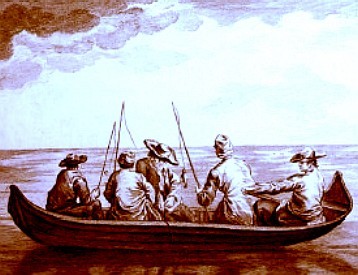
Fishing From a Canoe, From Traite general des Pesches, Plate 14, (1769)
and sending them off to fish. As already seen, Woodes Rogers talked about employing their yawl - a small sailboat - at Juan Fernandez Island in 1708. In another previously cited example, Dampier mentioned using their canoes to fish at Puerto San Julián, Argentina in 1685. Fellow buccaneer Basil Ringrose also talks about fishing from canoes while at Isle de la Plata, Ecuador in August of 1680.1 Jeremy Roch said that the men of the HMS Charles Galley "having nothing else to do, ...put our fishing craft awork and caught some fish, which was a little diversion as well as a refreshing to us, while we lay here" off of St. Helena in July of 1689.2 Clement Downing explained that HMS Salisbury rowed "our six-oar'd Boat" to fish at Santiago in the Cape Verde Islands in 1721.3 While at Juan Fernandez Island in January of 1720, privateer George Shelvocke sent his boats 'a fishing' and "while the boats were employ'd in catching fish, of which we salted as much as filled five puncheons"4. A puncheon is a cask which could hold about 72 gallons of liquid. While near Cabo Catoche, Mexico in December of 1724, Pirate Francis Spriggs "sent the Boat with three hands to fish"5.
Men could also fish from the ship itself. 
Artist: Gabriel Bray - A Sailor Fishing From a Cannon (1775)
Edward Barlow says that when the Fflorentine merchant ship reached Goodwin Sands on the English coast, they "hauled as near [to the sands] as we could lie, and not long after, looked out for land; and putting our fishing lines out, we took some mackerel as we sailed along"6. William Dampier mentions in 1684 that whenever the buccaneer Revenge would "come to an Anchor, we always ...put our Hooks and Lines over board, to try for Fish."7
A few accounts mention fishing from land. Nathaniel Uring explains that when the London Merchant was at Grandee Shoals (which today are the Geba River Shoals in Guinea-Bissau, Africa), "Our Capt. caried a net on shoar" and proceeded to attempt to catch fish from there.8 Explorer John Wood reported hunting and fishing while the crews of the Sweepstakes and Batchellor Pink wintered at Puerto San Julián, Chile in 1670.9 As already mentioned, the buccaneers with Dampier in 1685 found dried, salted fish in a salt water lake. They must have been edible, because when they came "abrest of that place, [we] sent in a Canoa mann'd with 12 Men for more Fish."10
In addition to where the sailors fished from, the method of fishing differ in the period sailor's literature. They include the use of fishing with a hook and line, a net and a harpoon. In the accounts under study, fishing with hook and line is mentioned 9 times, fishing with a net is mentioned in 8 citations and fishing with a harpoon is discussed 4 times.
Many of the hook and line citations have already been mentioned.11 Perhaps most interesting is that fishing poles are never mentioned, only the hook and line, although fishing poles existed long before this. Still, several near-period images show sailors simply fishing by dropping a line over the side. As late as 1755, Thomas Blankley's Naval Dictionary defined a fishing gear "Sett which consists of Nets, Lines, Hooks, &c"12 with no specific reference to fishing poles. William Dampier explained that when the Revenge was at Juan Fernandez Island in 1684, the fish were "so plentiful, that two Men in an hours time will take with Hook and Line, as many as will serve 100 Men."13 Fellow buccaneer Basil Ringrose said that while the May-flower under the command of John Cox was at Isla de la Plata in 1680, their canoe went out "for discovery, at night they returned on board, bringing some Fish that they had caught with hooks and lines."14
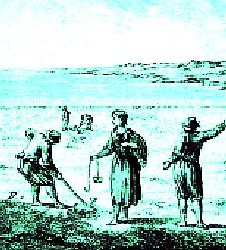
Fishing With Lines From Shore, From Traite
General des Pesches, Plate 17, (1769)
Of particular interest here are accounts of shipwrecked and marooned using the hook and line method to procure food. The privateer vessel Speedwell wrecked on Juan Fernandez in September, 1720 while trying to get water resulting in the crew spending several months there while building a new craft to take them back to the mainland. Captain George Shelvocke explained that their "boat was daily employ'd in fishing, the Armourer constantly supplying them with hooks, and there was no want of lines, which were made of twisted ribbon, of which a great quantity was driven ashore"15. (The fishing boat was not used to escape because it was too small to take everyone and its loss would have been difficult for the crew who remained behind.) Another stranded sailor, Richard Hawkins, escaped from from pirate Francis Spriggs' vessel in 1724, eventually making his way to Roaton in Honduras. He explains: "At length Tobias Martin, my boatswain, (who is come home with me,) found a Tenpenny Nail in the Canoe; this he crook’d like a Hook, and made it fast to a Line of the old Man’s [someone already on Roaton], and therewith caught a Rock-fish as large as a Cod"16. Somewhat astonishingly, they later managed to shoot a fish in shoal water.
Nets were used almost as often as hook and line in the period accounts of fishing, typically by being dragged behind a small boat. A fishing net is frequently referred to in these accounts as a 'seine', a word derived from the old English
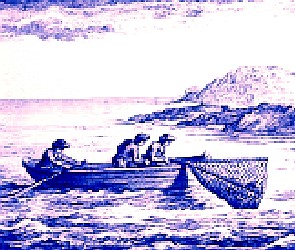
Fishing With A Net From a Boat, From Traite
General des
Pesches, Section 2, Plate 17, (1769)
'segne' or the old French 'saine'. Like many unusual words of the period, it is often spelled phonetically. Privateer John Wood calls it a 'Sean' in 167017, William Funnell refers to it as a 'Saine' while at Ilha Grande in 170418 and navy surgeon John Atkins calls it a 'Searn' while off the coast of Africa in the spring of 172119. Other accounts just refer to them as nets.20 Clergyman John Covel thought the name so unusual that he explained that the London Merchant's captain had "caried a net on shoar, which by all our Seamen was called a Sain... It was a sort of drag net."21 Covel was only a passenger, but his comment hints that the term seine may have been one used primarily by sailors, not necessarily by those on land.
When HMS Swallow and Weymouth were at Cape Palmas, Liberia in May of 1721, Atkins explained that they had "to hawl our Searn in the River" to catch fish for their provisions.22 Woodes Rogers provides a little more information when the Duke and Dutchess were at Angra dos Reis, Brazil in November of 1708: "our Men went in our Boat to hall our Fishing-Net, and caught some very good Fish"23. The most unusual description of using a net comes from Clement Downing, who says that when the Salisbury was at Santiago, Cape Verde in 1721, their boat "haled our Line, and in three Draughts; inclosed as much Fish as our six-oar'd Boat could carry on board at three times"24. The use of the word
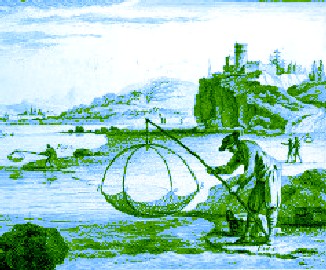
Fishing With Nets From Shore, Traite
General des Pesches (1769)
'Line' makes it sound as if they were using hook and line, but on of the definitions of 'draught' found in Samuel Johnson's Dictionary is, "The quantity of fishes taken by once drawing the net."25
Several of the reports of using a net to fish were quite positive. Atkins says that while in the bay of the river of Sierra Leone, Africa, "most of [the fish] we catch'd in great numbers with our Searn; two or three Hours in a Morning supplying a Belly-full to the whole Ship's Company."26 He similarly reported that they 'catched good store' of fish in the River at what is today Cape Palmas, Liberia.27 John Wood explained that while at 'Port Famine' (Isla Duke de Yorque, Strait of Magellan, Chile) "we took great quantities [of fish] with our Seans"28. Not every account was quite so glowing, however. When Covel talked about the captain bringing a net ashore to try and catch fish, he said, "we turned it twice or thrice in the sea, but we catch't few fish, and those very small ones."29
The last method of catching fish mentioned in the accounts is the least used of the three: a harpoon. Harpoon fishing is often described as being performed by Native Americans during the golden age of piracy. Dampier explained that when he was sailing with Captain Sharp in 1681 that had with them
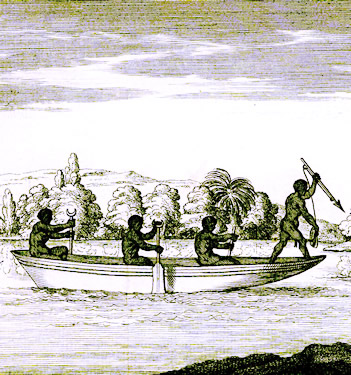
Natives Spear Fishing With A Net From a Boat, From Nouvelle Relation
de la France Equinoxiale (1743)
"two Moskito Indians who
always bear Arms amongst the Privateers, and are much valued by them for striking Fish, and Turtle or Tortoise, and Manatee or Sea Cow"30. He mentions them being sent out for fish when the Revenge was at Nicoya, Costa Rica in 1684.31 During his time sailing on the buccaneer Cygnet, the crew sent their Native spear fishers to harpoon fish for their Christmas dinner in 1685, as already described. While near Pagai-selatan, Indonesia in 1688, their 'strikers' "went out and struck some Fish, which was boiled for Supper. They also killed 2 young Aligators, which we salted for the next day."32
The only mention of an European using a harpoon in the accounts under study did not end well. Merchant sailor Nathaniel Uring decided to try his hand at the 'Fish-gigg' (fizgig - a harpoon with a barb on the end) while aboard the Martha in 1701. He managed to spear a string ray, but being "very large and strong, [it] swam away very swiftly, with the Gigg standing upright in his Back; and the Line hitching about my Foot had like to have pulled me over-board, and had not the Knot luckily slipp'd where the Line was fastn'd, I should have been in great Danger"33. Uring was concerned because he couldn't swim, but the line only grabbed his 'slipper' and he avoided going in the water. "The Loss of our Fish-gigg was a very great Misfortune to us, having no more on Board, and therefore could strike no more Fish, by which Means we lost many a good Meal during our Voyage."34
1 Basil Ringrose, The Adventures of Capt. Barth. Sharp, And Others, in the South Sea, 1684, p. 21; 2 Jeremy Roch, from Bruce S. Ingram, Three Sea Journals of Stuart Times, 1936, p. 115; 3 Clement Downing, A Compendious History of the Indian Wars, 1737, p. 79; 4 George Shelvocke, A Voyage Round the World by Way of the Great South Sea, 1726, p. 259-60; 5 “48. Nicholas Simmons, from The Memorandum of Nicholas Simmons”, Pirates in Their Own Words, Ed Fox, ed., 2014, p. 239; 6 Edward Barlow, Barlow’s Journal of his Life at Sea in King’s Ships, East and West Indiamen & Other Merchantman From 1659 to 1703, p. 258; 7 William Dampier, A New Voyage Round the World, 1699, p. 116; 8 John Wood, "Captain Wood's Voyage Through the Streights of Magellan, &c.", A Collection of Original Voyages, William Hacke, ed., 1699, p. 95; 10 Dampier, p. 241; 11 Including John Atkins, A Voyage to Guinea, Brazil and the West Indies, 1735, p. 32, Barlow, p. 258 & Dampier, p. 116, 257 & 465; 12 Thomas Riley Blankley, A Naval Expositor, 1755, 2nd ed., p. 56; 13 Dampier, p. 86; 14 Ringrose, p. 21; 15 Shelvocke, p. 239-40; 16 “59. Richard Hawkins' account of his capture by Francis Spriggs, from The British Journal, 8 August, 1724 and 22 August, 1724", Pirates in Their Own Words, p. 303-4; 17 Wood, p. 85;18 William Funnell, A Voyage Round the World, 1969, p. 12; 19 Atkins, p. 46 & 66; 20 Edward Coxere, Adventures by Sea of Edward Coxere, 1946, p. 19 & Woodes Rogers, A Cruising Voyage Round the World, 1712, p. 39; 21 John Covel, "Extracts from the Diaries of Dr. John Covel, 1670-1679," Early Voyages and Travels in the Levant, edited by J. Theodore Bent, 1893, p. 120; 22 Atkins, p. 66; 23 Rogers, p. 38-9; 24 Downing, p. 79; 25 Samuel Johnson, A dictionary of the English language, 1st part, 1755, not paginated; 26 Atkins, p. 46; 27 Atkins, p. 66; 28 Wood, p. 85; 29 Covel, p. 120-1; 30 Dampier, p. 1-2; 31 Dampier, p. 116; 32 Dampier, p. 474; 33,34 Nathaniel Uring, A history of the voyages and travels of Capt. Nathaniel Uring, 1928, p. 23

